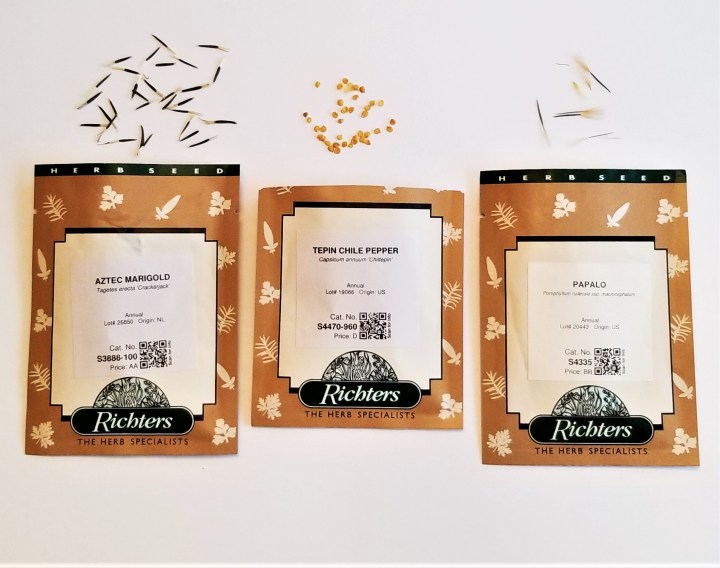
The ground is still covered with a white layer of snow in my backyard, but daylight times are getting longer, so I am ready to start some seed indoors. This year, I have found Richters™, a new-to-me seed and gardening company based in Ontario, Canada, which specializes in herbs, but also has a decent selection of veggies, flowers and garden supplies. I was blown away by the fact that they carry some Mexican varieties that I have been wanting to grow for some time at home, here in Southern Ontario. In the photo at the top of this post, from left to right:
1) Cempasúchil (Tagetes erecta) – From the Nahuatl forms cempoal and xochitl, literally “twenty flowers”, for their abundance; known in English as Mexican marigold, Aztec marigold, or wrongly, African marigold, this annual plant is originally native to Mexico. There, it is the traditional flor de muertos (flower of the dead), used extensively in altars and offerings for the Day of the Dead, on November 2 (photo below, left), when they may be found even at supermarkets (photo below, right):
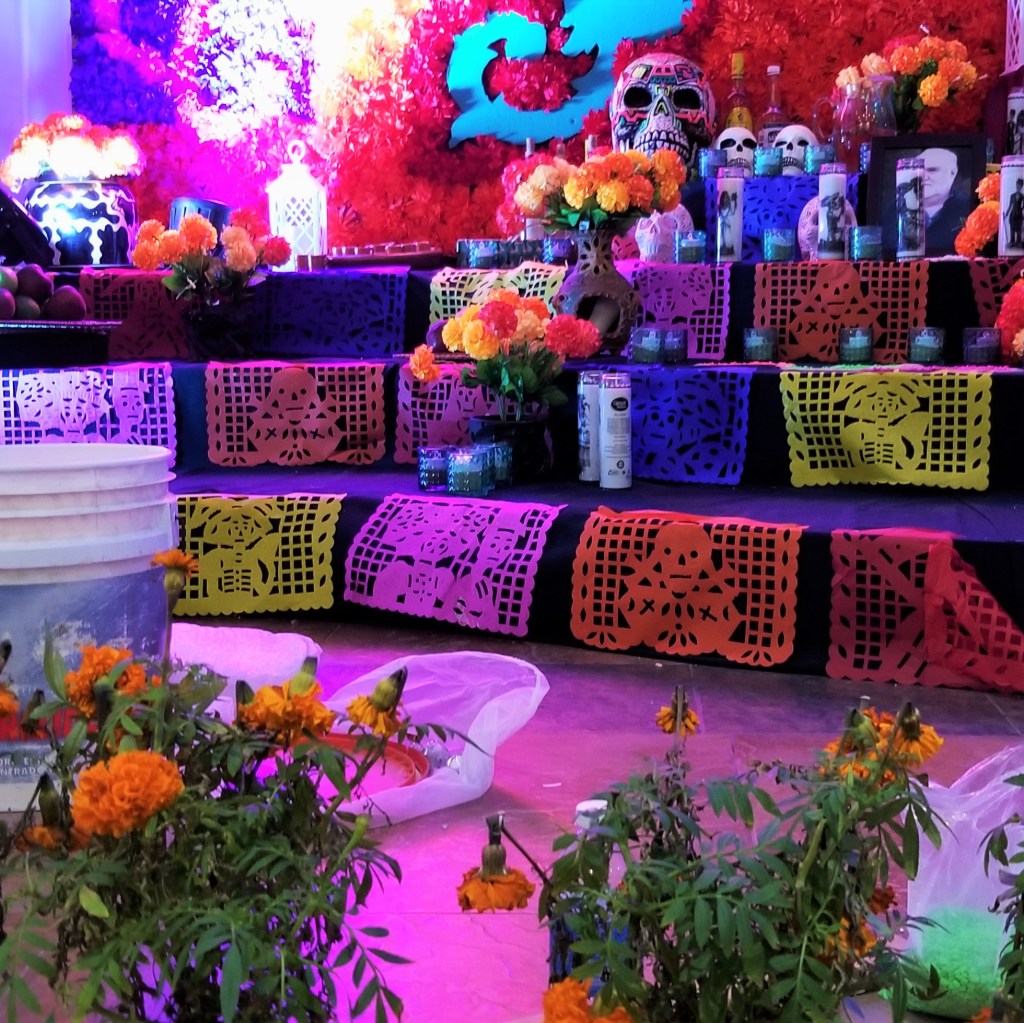
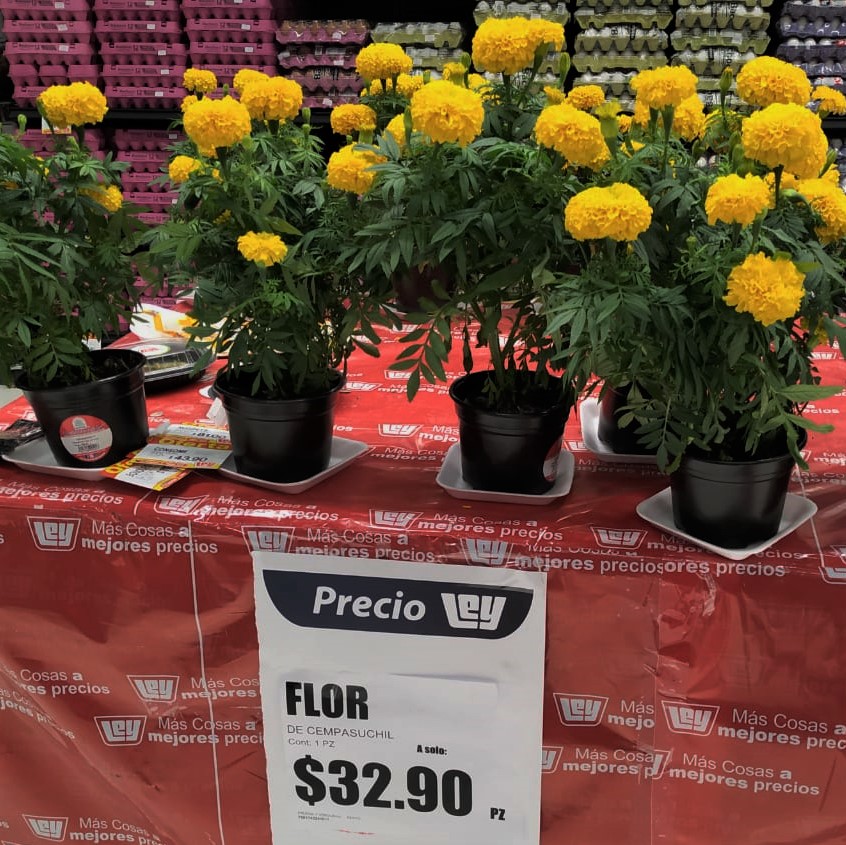
Aztec marigold is also used as an ornamental plant, frequently found girding garden beds. There are many hybrid varieties, but the ‘Crackerjack’ is a non-hybrid, and has been used as a medicinal and culinary plant since pre-Hispanic times by indigenous groups in extensive regions in the Americas, from the Cherokee (as a skin wash and edible dye) to the Aztec (as part of ceremonial practices, and healing), and as far south as Venezuela and Colombia. It is rich in carotenoids, particularly lutein, a compound reported in scientific studies as and effective anti-inflammatory with many beneficial effects, especially on eye health. When added to chicken feed for hens, carotenoids in marigold flowers also help egg yolks turn a deeper colour.
2) Chile Chiltepín (Capsicum annuum ‘Chiltepin’) – Also known as Tepín or Bird Pepper, Chiltepín is a pea-sized, round chile (hot pepper) that has grown in the wild in Mexico and the Southern United States since as far back as 10, 000 BC. It may be harvested while green, and eaten raw (photo below, left) or pickled, and also well ripened, when it turns red, consumed usually dry (photo below, right):

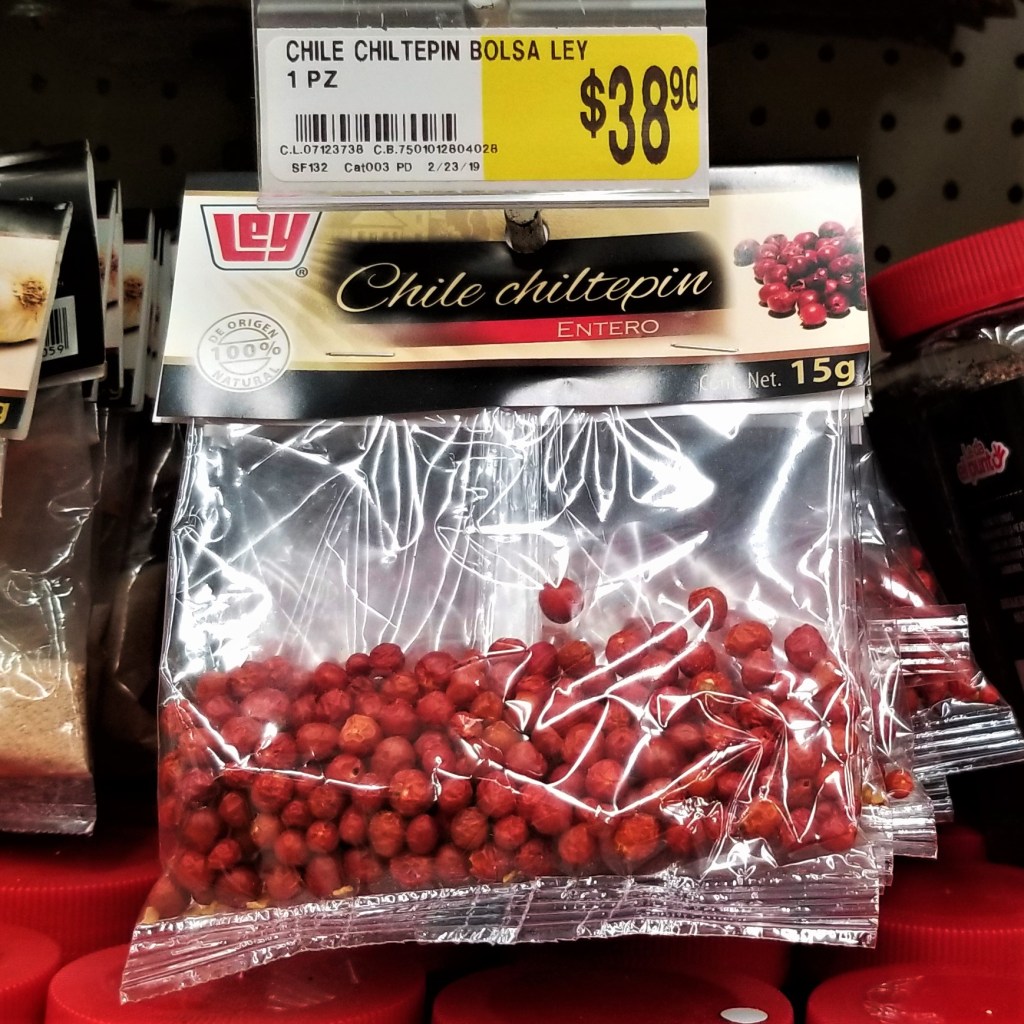
In a previous post, I followed the journey of this ancient pepper, thought to be the backbone ancestor of all cultivated Capsicum annum peppers, both sweet and spicy. The word chile comes from the Nahuatl word chilli, but the first European explorers called it “pepper”, confusing it with black pepper (Piper nigrum); looking at some bone-dry chiltepín fruits (photo below, left) it is not hard to imagine how they could have made that mistake. Rests from the earliest cultivated varieties of Capsicum annuum have a carbon-dating of between 6000 and 9000 years; a cultivated sibling of Chiltepín is Piquín (photo below, right) which, coming exactly from the same variety, has grown slightly bigger and elongated, simply from different conditions:
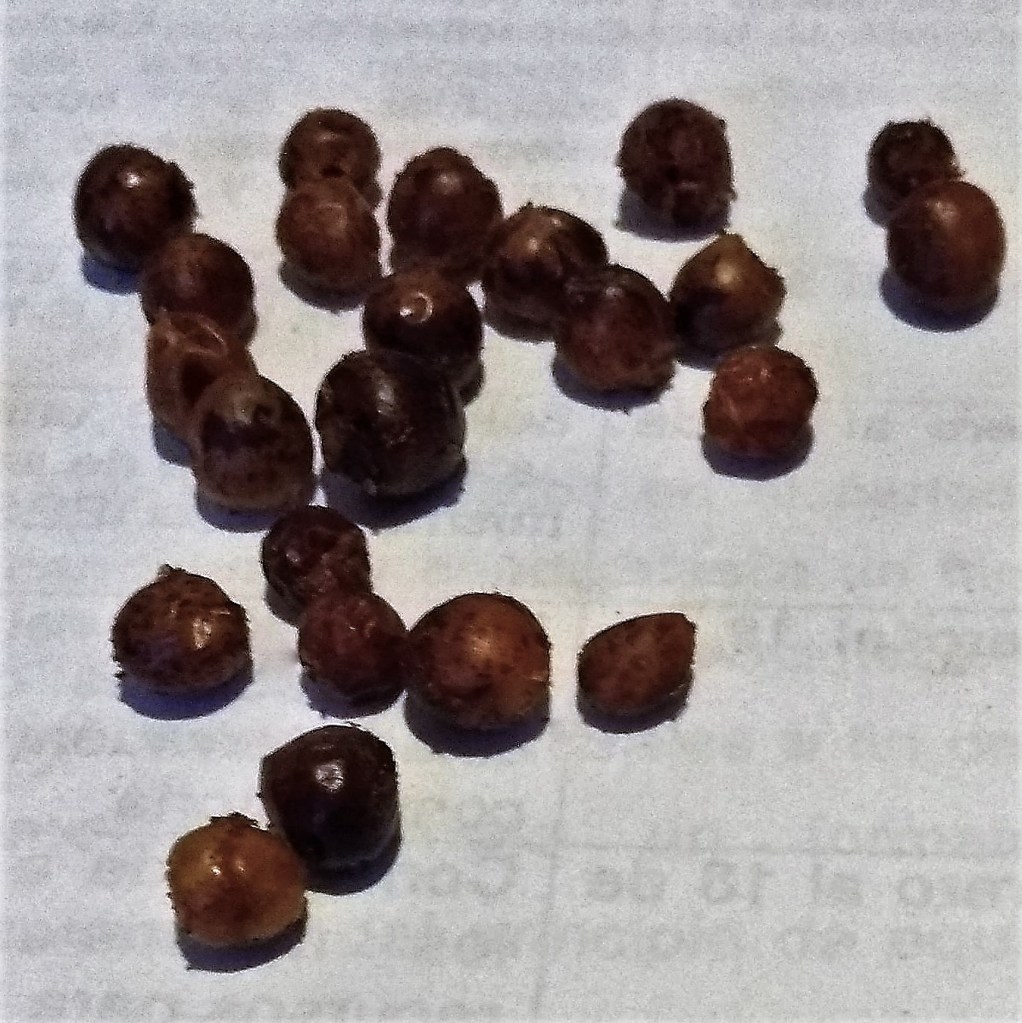
Dry Chiltepín hot peppers (Culiacan, Mexico, 2018)
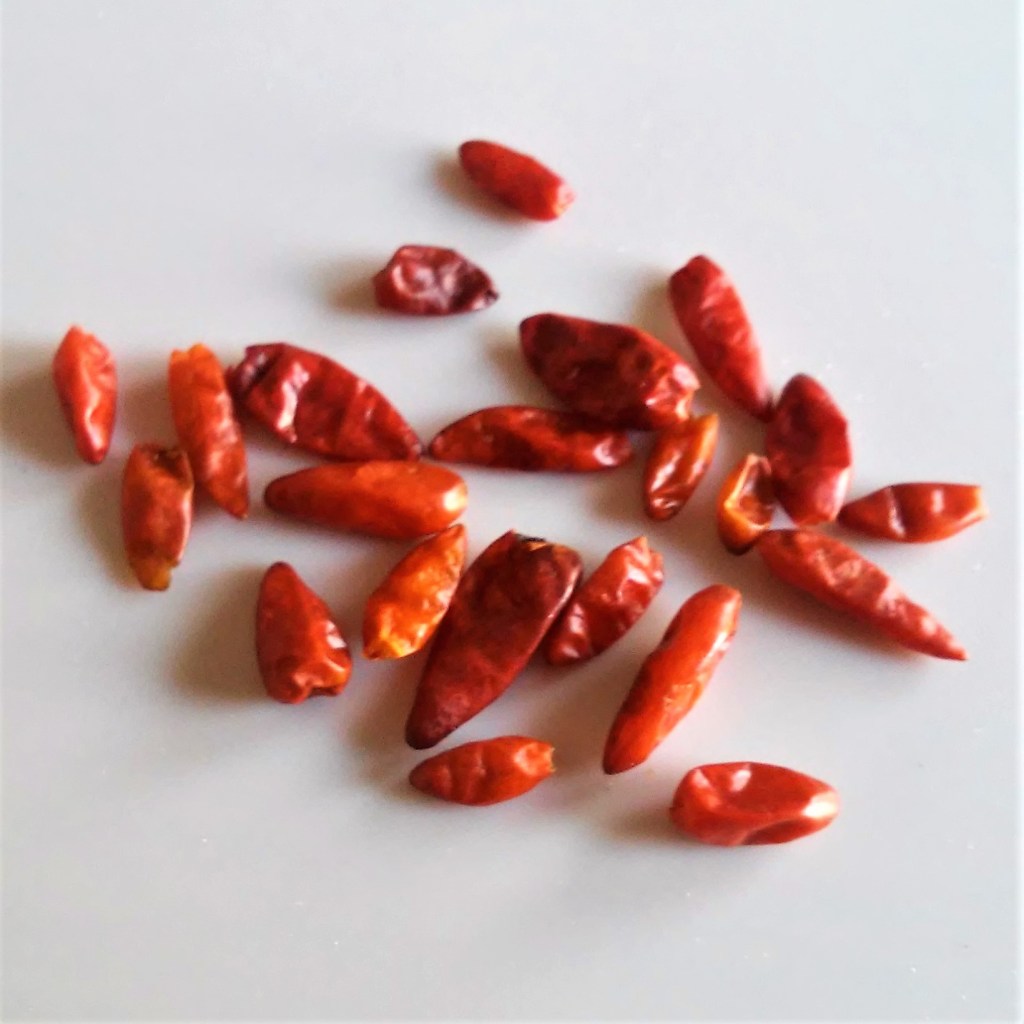
Dry Piquín hot peppers (Ontario, Canada, 2018)
From this example, it is easy to see the progression from Chiltepín to a few other wild varieties, to the thousands of different types of chiles around the world, in every shape, colour and level of spiciness. Until recent years, Chiltepín only grew in the wild, so I am thrilled to have a packet of cultivated viable seeds. It is a very hot pepper, with between 50,000 and 100,000 Scoville units, although its punch is usually short-lived.
3) Pápalo (Porophyllum ruderale ssp. macrocephalum) – From the Nahuatl word papalotl, meaning “butterfly”, this herb with wide leaves (hence the name) is native to Mexico and used in several Latin American countries, also known as Quilquiña, Yerba Porosa, Killi, and Pápalo quelite. Often described as a substitute for cilantro (Coriandrum sativum), these two herbs do not belong to the same botanical family; however, since cilantro (coriander) is an Old World plant, it is likely that in pre-Hispanic times, pápalo was the green herb of choice. The flavour is earthy and pungent, indeed like cilantro, only stronger, coming from oil glands in the leaves. It thrives in hot weather, growing to up to 2m (8ft) high, even developing bark-like, hard stems. The older it grows, the more pungent, so it is commonly harvested at the younger stage when the flavour is at its peak. In Mexico, it is used always fresh in soups and stews, or with grilled meats, and most famously, on street tacos and cemitas (a sandwich from the Mexican state of Puebla, prepared on a local bun of the same name.) I had never found any sources of pápalo in Canada, and must confess never to have tried it, so this is going to be a completely novel adventure for me.
To have an idea of how Pápalo looks like, and for your convenience, click on the image below, along with other products available on Amazon™. DISCLAIMER: Any reviews included in this post are my own, for items I have purchased, not provided by any company; as an Amazon Associates Program affiliate, I might receive a commission for any purchases originated from the links below, at no extra cost to you (thank you to readers who have bought other products starting with a click from my links!):











I think it’s still a little early to start seeds here, or maybe I’m just refusing to think about it! The one thing I’ll have to start from seeds are tomatillos. Nobody at nurseries here knows what they are, which is why I’ve never seen them here, so I ordered seeds. Supposedly bugs really like the leaves so I might plant about 100 plants!
LikeLike
I start new-to-me crops early and indoors, so I know how long they will take to germinate and how their sprouts will look; that helps me both if I am transplanting outdoors, to give them a head-start, and to have better control when sowing seed directly in the ground later in the season. My tomatillos always start very fragile (indoors), but if they survive the first month, they usually give me a good harvest (outdoors); it’s not a bad idea to plant many, if they all survive, you can always make preserves and salsa verde galore. Happy gardening, Chef Mimi!
LikeLiked by 1 person
You’re inspiring me, Irene!
LikeLike
Happy gardening, MsJadeLi!
LikeLiked by 1 person
And, so it starts! I’ve got my oregano, thyme, and some basil started. Kale is planted, but not up yet. The excitement of the season starts to build; enjoy!
LikeLike
Indeed, thank you, enjoy as well, Lou!
LikeLike
I always wondered why chilis were called peppers! I haven’t even remotely begun thinking about my garden. Yikes.
LikeLike
I couldn’t imagine the confusion until I saw dry chiltepín, the original chile, and yeah, then I could. I am always known to be an impatient gardener, so it’s not you, it’s me, LOL.
LikeLiked by 1 person